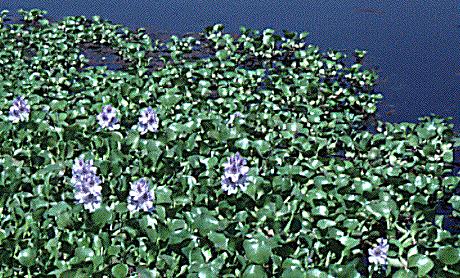



Monocots: Life History and Ecology
Monocot ecology is too diverse to discuss beyond generalizations or on a group
by group basis. For information beyond that presented below, you might look
at the ecology and life history pages of the
plants, the
seed plants,
or the flowering plants.
We recommend that you look at those pages, or click on the
"Systematics" button at the top of this page to access information on
specific groups of monocots.
Monocots grow in a wide range of habitats.
Monocots are primarily tropical, with the exception of the
Liliales,
Asparagales, and
Glumiflorae.
In fact most species were completely unknown before intensive tropical
botany began in this century. Despite their greatest numbers being present
in the tropics, many monocots exist in other environments as well -- along and
in streams and ponds, in coastal marine environments, in deserts,
and even on the arctic tundra.
 Most large floating and submerged aquatic plants are monocots, mostly in the
Alismatiflorae. Water hyacinths, duckweed, and pondweed are all aquatic
monocots. Some of these, such as the water hyacinth (Eichhornia)
have become serious weeds in American waterways; the picture above shows
a dense patch of Eichhornia crassipes growing west of Stockton,
California. A number of aquatic monocots have
also become popular in fresh-water aquariums, such as Valisneria
and Potamogeton. Perhaps the most important of these aquatic
monocots are the sea grasses, which provide food and habitat for a wide
variety of marine organisms.
Most large floating and submerged aquatic plants are monocots, mostly in the
Alismatiflorae. Water hyacinths, duckweed, and pondweed are all aquatic
monocots. Some of these, such as the water hyacinth (Eichhornia)
have become serious weeds in American waterways; the picture above shows
a dense patch of Eichhornia crassipes growing west of Stockton,
California. A number of aquatic monocots have
also become popular in fresh-water aquariums, such as Valisneria
and Potamogeton. Perhaps the most important of these aquatic
monocots are the sea grasses, which provide food and habitat for a wide
variety of marine organisms.
Some of the most successful monocots to arrive rather late on the scene are the
Glumiflorae,
which include the grasses, sedges, rushes, and cattails. Though their fossil
record extends back almost to the Cretaceous, these plants first began to
dominate large areas only in the Oligocene and
Miocene, when the
Earth's climate cooled considerably. At that time, grasslands appeared as a
major global vegetation type for the first time. Sedges and rushes became
important in ponds and bogs, and also on the tundra.
One of the more novel habitats which plants occupy is the surface of trees and
other large plants. These plants are called epiphytes, and are common
among the monocots. Bromeliads,
aroids, and
orchids
all have numerous species which live in the tops of tropical trees.

Image of Eichhornia courtesy the Jepson Herbarium, and used by permission.













